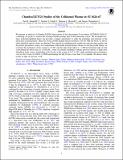Chandra/LETGS Studies of the Collisional Plasma in 4U 1626–67
Author(s)
Hemphill, Paul B; Schulz, Norbert S; Marshall, Herman L; Chakrabarty, Deepto
DownloadPublished version (1.241Mb)
Publisher Policy
Publisher Policy
Article is made available in accordance with the publisher's policy and may be subject to US copyright law. Please refer to the publisher's site for terms of use.
Terms of use
Metadata
Show full item recordAbstract
We present an analysis of \chandra/LETGS observations of the ultracompact
X-ray binary (UCXB) 4U 1626$-$67, continuing our project to analyze the
existing
Chandra gratings data of this interesting source. The extremely low mass,
hydrogen-depleted donor star provides a unique opportunity to study the
properties and structure of the metal-rich accreted plasma. There are strong,
double-peaked emission features of OVII-VIII and Ne IX-X, but no other
identified emission lines are detected. Our spectral fit simultaneously
models the emission line profiles and the plasma parameters, using a
two-temperature collisionally-ionized plasma. Based on our line profile
fitting, we constrain the inclination of the system to 25--60$^{\circ}$ and
the inner disk radius to $\sim$1500 gravitational radii, in turn constraining
the donor mass to $\lesssim$0.026 M_sun, while our plasma modeling confirms
previous reports of high neon abundance in the source, establishing a Ne/O
ratio in the system of $0.47 \pm 0.04$, while simultaneously estimating a
very low Fe/O ratio of $0.0042 \pm 0.0008$ and limiting the Mg/O ratio to
less than 1% by number. We discuss these results in light of previous work.
Date issued
2021Department
MIT Kavli Institute for Astrophysics and Space ResearchJournal
Astrophysical Journal
Publisher
American Astronomical Society
Citation
Hemphill, Paul B, Schulz, Norbert S, Marshall, Herman L and Chakrabarty, Deepto. 2021. "Chandra/LETGS Studies of the Collisional Plasma in 4U 1626–67." Astrophysical Journal, 920 (2).
Version: Final published version